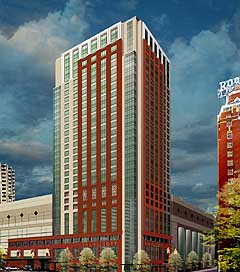
DJC.COM
June 7, 2001
Thinking outside the box
MulvannyG2 Architecture

Image courtesy of MulvanneyG2 Architecture |
The Elliott Grand Hyatt Seattle was a very complex, technically challenging commission.
The 30-story luxury hotel occupies an entire city block. In addition to its 425 rooms, it includes 40,000 square feet of retail space at street level on three sides and a concealed five-level, 950-stall parking garage. Located above the parking levels is an additional 98,000 square feet of new expansion space for the adjacent Washington State Convention & Trade Center.
R.C Hedreen and Co. is the developer and general contractor of the $145 million project, which was designed by MulvannyG2 Architecture.
The biggest architectural challenge was the sheer scale and bulk of the project. The base structure alone is taller than the buildings across the street. The scale of this huge, windowless façade needed to be minimized and treated carefully so it would complement the adjacent buildings, including the venerable Roosevelt Hotel.
|
The design solution was to compose the entire block to feel like a series of facades, instead of one big megastructure. The facade was minimized through articulation, material changes, colors, detailing and a number of different vertical elements. Numerous corners and wall terminations have exploded the “box” feel of it.
The design at the street level also played an important part in reducing the scale of the project. Granite columns, aluminum-clad canopies with patterned glass, and custom lighting and signage were used. This also enabled pedestrians and shoppers to appreciate the hotel’s scale and elegance.
Integrating the hotel tower with the base structure was another big design challenge because the hotel tower footprint is only about a quarter of the total site. The design solution was to incorporate a number of vertical elements that are shaped like “bundled tubes” to increase the sense of the building’s vertical height. The color of the building also played a role in this integration. As the building rises, the color scheme lightens until it reaches the very top where there’s a very lightly colored “crown.”
The hotel tower, situated on the northwest corner of the project structure, also had to fit in with the adjacent buildings such as the Roosevelt Hotel. In many ways, the Roosevelt helped inspire the design of the Elliott hotel, which is intended to portray an elegant, classic and contemporary design interpretation of the Roosevelt. The color of the buildings, the modulations, and even the width of the column and spandrel panels are all very similar.
The color and materials of the hotel tower and the base structure are also purposely very compatible to the neighboring convention center. The design of the overall project is a balance between the adjacent buildings and the joining of private and public developments. The hotel block design kept the private development harmonious with the public convention center, as well as the connected convention center expansion space.
A dramatic element of the overall project is the glass canopy and pedestrian bridge that spans Pike Street and connects the Elliott hotel and the convention center. MulvannyG2 worked closely with LMN Architects, the convention center’s architectural firm, to design the project’s Pike Street façade so that it accepted the canopy. This façade provides the link between the private development and the public convention center. It will form one of Seattle’s major assembly areas and will be an extension of the nearby Westlake Center.
The hotel’s interiors, designed by Zena Design Group, will be filled with the latest technology. Each room will be equipped with an “invisible computer” and a powerful Web-based multimedia system. The hotel will also feature a fully wired, 150-seat presentation theater with data ports at each seat. To reflect its luxury status, Hedreen is placing a number of original art pieces throughout the hotel, such as a Willem de Kooning bronze sculpture at the entrance.
One of the main aspects of the overall project was the in-depth interaction between the private/public development team and the public authorities. With all the architectural elements and private/public intangibles, it took two full years to complete the project’s design planning, coordination and approval.
The end result is more than just an elegant hotel. The Elliott hotel is now one of only a handful of projects across the U.S. that has developed a number of mixed-use elements in tandem with public and private development.
Gerry Gerron, MulvannyG2 Architecture vice president and principal in charge of design, was the lead architect on the Elliott hotel. Ted Caloger, MulvannyG2 vice president, was the project manager for the Elliott hotel. Gerron and Caloger have more than 60 years of combined architectural experience and have worked together on numerous distinguished corporate office and mixed-use projects throughout the Seattle area.
Other Stories:
- Expanding for the future
- Hey, big spender! You’re wanted in Seattle
- A bridge to controversy
- Convention center showcases public art
- Un-conventional sites add complexity to convention center design
- From concept to reality
- Dance of the developers
- Center expansion resulted in more affordable housing
- A 'shimmering' canopy belies some steely calculation
Copyright ©2009 Seattle Daily Journal and DJC.COM.
Comments? Questions? Contact us.